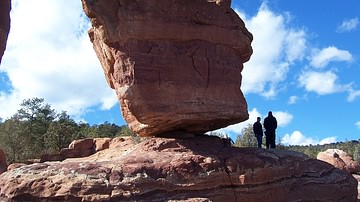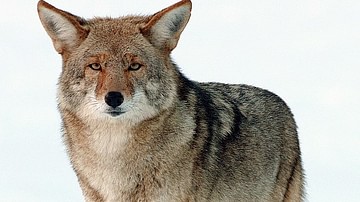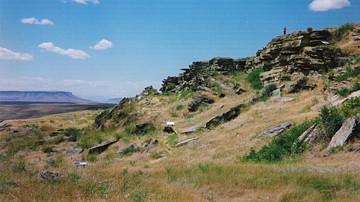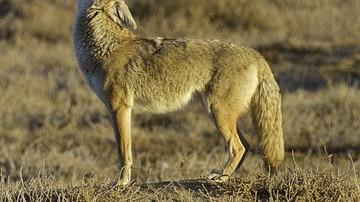Wihio and Coyote is a tale of the Cheyenne nation featuring the trickster figure Wihio in the dual role of villain and victim. The trickster figure appears in the stories of many different Native American nations as an often unwilling or unaware teacher of central cultural values. He may be a villain, hero, or fool, but he always teaches something.
Wihio is similar in character and narrative purpose to the same archetypal figures in the lore of other Native peoples of North America, such as Iktomi (Unktomi) of the Lakota Sioux, Coyote of the Navajo, or Glooscap of the Algonquin. Like these, Wihio tales always teach important life lessons and, also like these other trickster figures, Wihio is sometimes depicted as a man but may assume other forms depending on the story and the intended moral.
Wihio the Trickster
He is also known as Weeho, Vihio, Veho, and Vihuk and, like Iktomi and others, is associated with spiders as he is often spinning webs in which he winds up caught himself. Wihio stories, like Iktomi tales, also either directly or indirectly involve some sort of transformation. Wihio either learns a lesson – or, at least, is presented with the opportunity to learn – or teaches a lesson to others but, either way, the audience is instructed in the importance of some communal or cultural value while also being entertained. Anthropologist and writer George Bird Grinnell writes:
The Wihio stories of the Cheyenne belong to the widely spread series of Indian tales which deal with the acts and adventures of the trickster, variously known as Nana bosho, Napi, Coyote, and by other names. He possesses supernatural power and is on terms of friendship with the birds and the animals, and in him malice and simplicity are curiously combined. He is always more or less in difficulties…[he] occasionally appears in stories of a more serious character and is sometimes appealed to for help and may give it. More often, however, he fills the role of mischief-maker or villain. (Campfires, 281)
Like Iktomi, he is also often portrayed as a buffoon. In the story Wihio Loses His Hair, for example, he is tricked by two young girls who fill his hair with burrs, and he then must ask some field mice to gnaw all his hair off. When he comes home looking foolish, however, he saves face by telling his family he heard they had died and so cut his hair as a sign of his great grief. In this tale, Wihio is a clownish figure whose main purpose is to entertain, but in many others, he plays a more serious role.
In Wihio and Coyote, he appears as both a villain and a fool. He tricks the dogs and ducks but is then tricked by the coyote. Since the coyote was associated with Wihio, it is possible the story is relating two sides of the figure in conflict with himself: the foolish villain and the clever teacher or, even, avenger of wrongs. The story is similar to the Sioux tale Iktomi and the Coyote but is more complex in that, here, the coyote plays a more significant role in teaching the lesson.
However the Wihio figure is presented, he always offers an audience the opportunity for transformation on some level, just like the trickster figures of other Native American nations and world cultures. In this story, the lesson offered is open to interpretation by the audience – as it is in many other Wihio tales – and what one takes away from the tale is thought to be the message one needed to hear.
Text
The following text comes from By Cheyenne Campfires by George Bird Grinnell:
There was a stream running through a level country and Wihio was traveling along its banks. He seemed to have come a long way, for he looked tired. On his back he was carrying a sack.
At length, he came to a prairie dog town. The dogs were all standing up around the holes or feeding near them.
One of the dogs called across to Wihio, "Friend, where are you going?"
The man answered, "I am going into the upper country to sing for some people."
"What have you in your pack?" asked the dog.
Wihio said, "I am carrying my songs in my pack."
One of the dogs called out, "Come over here and sing for us."
"No," replied Wihio, "I am in a hurry, you will keep me. I have a long way to go before night."
The dog said to him, "Oh, come on, sing for us."
"Well," answered the man, "I will sing for you a little while, so that you can dance."
Wihio told them all to stand around in a circle. Then he picked out certain ones and put them side by side to dance together. These that he had chosen were all the fattest ones.
He said to the dogs: "Now, while you are dancing, you must all keep your eyes shut. Do not open them; do not look."
Then he began to sing, and they to dance. He took off his bundle and unwrapped it, and took from it a club, and as the dogs danced before him, he knocked the fattest ones on the head, one at a time. One dog was left, still dancing; he was afraid to open his eyes. But, as he heard no footsteps of others dancing, he stretched out. His paws, and he could feel no one else and, at last, he opened his eyes and saw that all the others were dead. He called out, "Oh, he has killed us all!" and ran away to his hole.
Wihio took the dogs to the stream and kindled a fire and singed them and roasted them and had a great feast there. When he had eaten them all, he took up his bundle and started on up the stream.
He followed up the creek, going around the bends, and across sandbars, and at length he came to a place where many ducks were swimming about. He pretended not to see them and, when he had passed them, one of the ducks said to his fellows, "There goes Wihio," and called to him.
Wihio stopped and looked around and one of the ducks said, "What is it that you are carrying on your back?"
The man answered, "These are my songs."
One of the ducks asked him if he would not stop and sing for them.
"No," said Wihio, "I have a long way to go. I have to go and sing for some other people."
"Oh," said the duck, "Just sing us a song or two; it won't take you long."
Then he turned back to them and said, "Well, I will sing for you. Come out here where it is level, and you can dance."
The ducks were all glad that he was going to sing, and came out to the level place, at a little distance from the water. Wihio said, "Now, you must all stand in a circle."
He took his bundle from his back and began to open it, and said: "You must all dance here with your eyes shut. If you open them, you will have bad eyes; they will be red."
Then he sang, and the ducks began to dance and, as they danced by him, he tapped one on the head with his club and pulled it out of the circle, and then another and another. Every little while he would call out to them, "Dance hard, now!"
The little grebe was anxious to see what was going on and, pretty soon, he opened his eyes just a little way, and saw what Wihio was doing. He called out, "Oh, he is killing us all! Then he and all the other ducks ran away to the creek and into the water and disappeared.
Wihio said to himself, "I will teach them to want songs and to dance; I will eat them."
He gathered up the ducks he had killed and took them to a place where there was a good shade and got them ready for cooking. After they were cleaned, he stuck them up on green sticks about the fire to roast and one very fat one he put in the ashes to roast, saying, "I will eat that one last."
A long way off, there was a coyote who must have smelled the cooking and, perhaps, caused a little wind to blow, just enough to move the trees. Two branches of the two trees Wihio was sitting under were crossed and, as the wind blew, they rubbed together and made a screeching noise.
Wihio called out to the trees: "What are you quarreling about? Why don't you stop it?" The noise continued and Wihio spoke to the trees two or three times and, at last, he got up to stop it.
He climbed one of the trees and went up the crossing branches and again said, "Why do you trees quarrel? Stop it!" He put his hand between the two branches and tried to push them apart; but they closed on his hand, and he found he could not pull away. As he sat there, a prisoner, he saw a coyote come over the hill, looking about and smelling.
Wihio said to the trees, "Let me go now; there comes a coyote. He will eat my food."
But the trees did not answer or move.
When the coyote got closer, Wihio called out to him: "Do not come smelling about here. I will not give you anything to eat."
The coyote got still closer and Wihio said to the trees again: "Let me go! Let me get down! He will eat my food, I tell you."
The trees still held him.
The coyote came still closer to the fire and Wihio called out to him again: "Go away, Little Face! I will not give you anything."
When the coyote heard this, he came on faster and, when he got to the fire, he ate up all the food that was there. Wihio kept pulling and working hard to get his hand loose, but he could not free it. Before the coyote had eaten all the food, Wihio called out to him, "Do not eat all; you have had plenty."
The duck that was roasting in the ashes Wihio had stuffed with meat, cut up fine, and he thought that it would be very good. He called out to the coyote, "You have eaten all the rest, do not eat the one I have in the ashes."
When the coyote heard this, he took the duck out of the ashes, ate all the meat that it was stuffed with, filled it full of dry ashes, and put it back where it had been. Then he went away.
At last, Wihio managed to get his hand free, for now the trees let him go. He climbed down and went to the fire and saw that all his food was gone. But he said to himself, "That rascal missed the best piece," and he dug down in the ashes for the duck that was covered up. He took a big bite out of it and then he began to spit, for he found that he had a mouthful of ashes. He said of the coyote: "He has treated me badly. If ever I find him, I will kill him."
He determined to punish the coyote, and to catch him he followed his tracks. At length, he came up with him and found him asleep on the sunny side of a hill, for the coyote was full, and went to sleep as soon as he lay down. Wihio walked up to the coyote and stood looking at him and said: "There lies the sharp-nosed thing. I will kill and eat him. Now, how shall I kill him? If I hit him in the ribs, it will bruise and spoil the meat. If I hit him on the head, it will spoil that. If I scare him to death, it will not be good either." So he considered.
Now, all the time he was talking to himself, the coyote was awake, and lying with his eyes partly open, watching him. While Wihio was try8ing to think how to kill him, the coyote suddenly jumped to his feet and ran off. Wihio said, "You got away from me that time, but next time I catch you I shall kill you."
Again, he started on coyote's trail and followed him; and at last came up with him and found him asleep under a pile of driftwood. When he found him, he called him all kinds of bad names and then he began to try to decide in what way he should kill him. He kept saying: "I wonder how I can kill him without bruising him. If I were to throw him in the creek and drown him, that would spoil him. I will make a big fire and throw him into it and burn him to death. He will roast at the same time, and then I can eat him."
By this time the coyote had awakened, but he did not move. He lay there as if sound asleep. Wihio took some of the driftwood and built a big fire and stooped down to take the coyote up by all four legs. He said, "If I throw him in the fire hard, it will bruise him; I will lay him in it gently."
He walked up to the fire and held the coyote over it, to lay him down on it, but, just as he was placing him there, the coyote gave a spring and jumped out of his hands on the other side of the fire. He jumped into the river and swam across it and climbed up on the other bank, looking back at Wihio. Wihio saw him no more.






